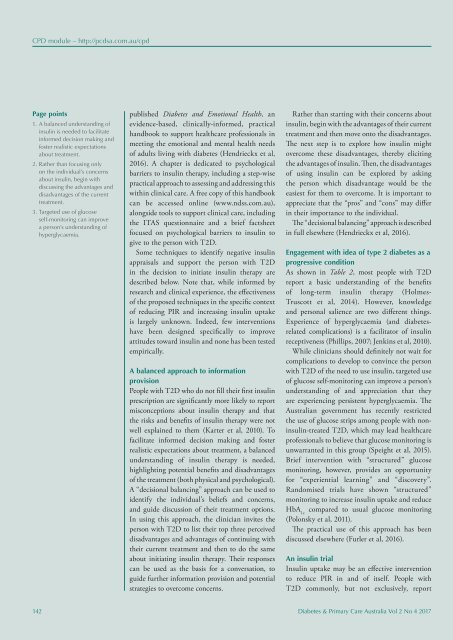DPCA 2-4_139-45
You also want an ePaper? Increase the reach of your titles
YUMPU automatically turns print PDFs into web optimized ePapers that Google loves.
CPD module – http://pcdsa.com.au/cpd<br />
Page points<br />
1. A balanced understanding of<br />
insulin is needed to facilitate<br />
informed decision making and<br />
foster realistic expectations<br />
about treatment.<br />
2. Rather than focusing only<br />
on the individual’s concerns<br />
about insulin, begin with<br />
discussing the advantages and<br />
disadvantages of the current<br />
treatment.<br />
3. Targeted use of glucose<br />
self-monitoring can improve<br />
a person’s understanding of<br />
hyperglycaemia.<br />
published Diabetes and Emotional Health, an<br />
evidence-based, clinically-informed, practical<br />
handbook to support healthcare professionals in<br />
meeting the emotional and mental health needs<br />
of adults living with diabetes (Hendrieckx et al,<br />
2016). A chapter is dedicated to psychological<br />
barriers to insulin therapy, including a step-wise<br />
practical approach to assessing and addressing this<br />
within clinical care. A free copy of this handbook<br />
can be accessed online (www.ndss.com.au),<br />
alongside tools to support clinical care, including<br />
the ITAS questionnaire and a brief factsheet<br />
focused on psychological barriers to insulin to<br />
give to the person with T2D.<br />
Some techniques to identify negative insulin<br />
appraisals and support the person with T2D<br />
in the decision to initiate insulin therapy are<br />
described below. Note that, while informed by<br />
research and clinical experience, the effectiveness<br />
of the proposed techniques in the specific context<br />
of reducing PIR and increasing insulin uptake<br />
is largely unknown. Indeed, few interventions<br />
have been designed specifically to improve<br />
attitudes toward insulin and none has been tested<br />
empirically.<br />
A balanced approach to information<br />
provision<br />
People with T2D who do not fill their first insulin<br />
prescription are significantly more likely to report<br />
misconceptions about insulin therapy and that<br />
the risks and benefits of insulin therapy were not<br />
well explained to them (Karter et al, 2010). To<br />
facilitate informed decision making and foster<br />
realistic expectations about treatment, a balanced<br />
understanding of insulin therapy is needed,<br />
highlighting potential benefits and disadvantages<br />
of the treatment (both physical and psychological).<br />
A “decisional balancing” approach can be used to<br />
identify the individual’s beliefs and concerns,<br />
and guide discussion of their treatment options.<br />
In using this approach, the clinician invites the<br />
person with T2D to list their top three perceived<br />
disadvantages and advantages of continuing with<br />
their current treatment and then to do the same<br />
about initiating insulin therapy. Their responses<br />
can be used as the basis for a conversation, to<br />
guide further information provision and potential<br />
strategies to overcome concerns.<br />
Rather than starting with their concerns about<br />
insulin, begin with the advantages of their current<br />
treatment and then move onto the disadvantages.<br />
The next step is to explore how insulin might<br />
overcome these disadvantages, thereby eliciting<br />
the advantages of insulin. Then, the disadvantages<br />
of using insulin can be explored by asking<br />
the person which disadvantage would be the<br />
easiest for them to overcome. It is important to<br />
appreciate that the “pros” and “cons” may differ<br />
in their importance to the individual.<br />
The “decisional balancing” approach is described<br />
in full elsewhere (Hendrieckx et al, 2016).<br />
Engagement with idea of type 2 diabetes as a<br />
progressive condition<br />
As shown in Table 2, most people with T2D<br />
report a basic understanding of the benefits<br />
of long-term insulin therapy (Holmes-<br />
Truscott et al, 2014). However, knowledge<br />
and personal salience are two different things.<br />
Experience of hyperglycaemia (and diabetesrelated<br />
complications) is a facilitator of insulin<br />
receptiveness (Phillips, 2007; Jenkins et al, 2010).<br />
While clinicians should definitely not wait for<br />
complications to develop to convince the person<br />
with T2D of the need to use insulin, targeted use<br />
of glucose self-monitoring can improve a person’s<br />
understanding of and appreciation that they<br />
are experiencing persistent hyperglycaemia. The<br />
Australian government has recently restricted<br />
the use of glucose strips among people with noninsulin-treated<br />
T2D, which may lead healthcare<br />
professionals to believe that glucose monitoring is<br />
unwarranted in this group (Speight et al, 2015).<br />
Brief intervention with “structured” glucose<br />
monitoring, however, provides an opportunity<br />
for “experiential learning” and “discovery”.<br />
Randomised trials have shown “structured”<br />
monitoring to increase insulin uptake and reduce<br />
HbA 1c<br />
compared to usual glucose monitoring<br />
(Polonsky et al, 2011).<br />
The practical use of this approach has been<br />
discussed elsewhere (Furler et al, 2016).<br />
An insulin trial<br />
Insulin uptake may be an effective intervention<br />
to reduce PIR in and of itself. People with<br />
T2D commonly, but not exclusively, report<br />
142 Diabetes & Primary Care Australia Vol 2 No 4 2017
















